常见英文连接词和句型总结讲解学习
- 格式:doc
- 大小:54.50 KB
- 文档页数:8
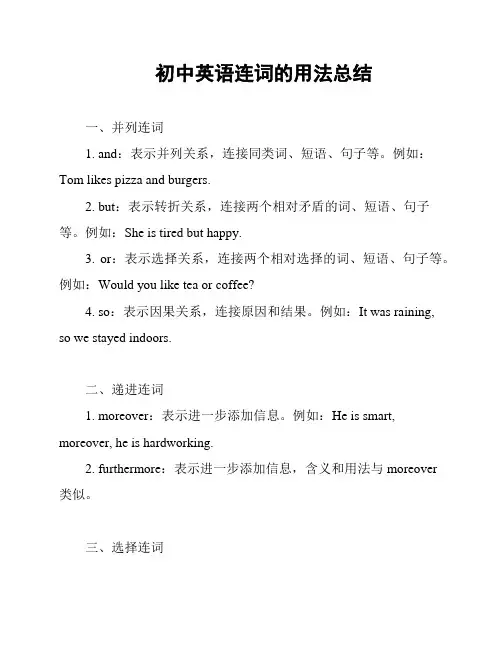
初中英语连词的用法总结一、并列连词1. and:表示并列关系,连接同类词、短语、句子等。
例如:Tom likes pizza and burgers.2. but:表示转折关系,连接两个相对矛盾的词、短语、句子等。
例如:She is tired but happy.3. or:表示选择关系,连接两个相对选择的词、短语、句子等。
例如:Would you like tea or coffee?4. so:表示因果关系,连接原因和结果。
例如:It was raining, so we stayed indoors.二、递进连词1. moreover:表示进一步添加信息。
例如:He is smart, moreover, he is hardworking.2. furthermore:表示进一步添加信息,含义和用法与moreover类似。
三、选择连词1. either...or:表示“或者...或者...”。
例如:You can either studyor play games.四、因果连词1. because:表示原因,引导原因状语从句。
例如:He couldn't sleep because he was nervous.2. since:表示原因,引导原因状语从句,与because意思相同。
3. therefore:表示结果,引导结果状语从句。
例如:She studied hard, therefore she passed the exam.五、条件连词1. if:表示条件,引导条件状语从句。
例如:If it rains, we will stay at home.六、让步连词1. although:表示让步,引导让步状语从句。
例如:Although it was raining, they went to the park.2. even though:表示让步,引导让步状语从句,意思与although相同。
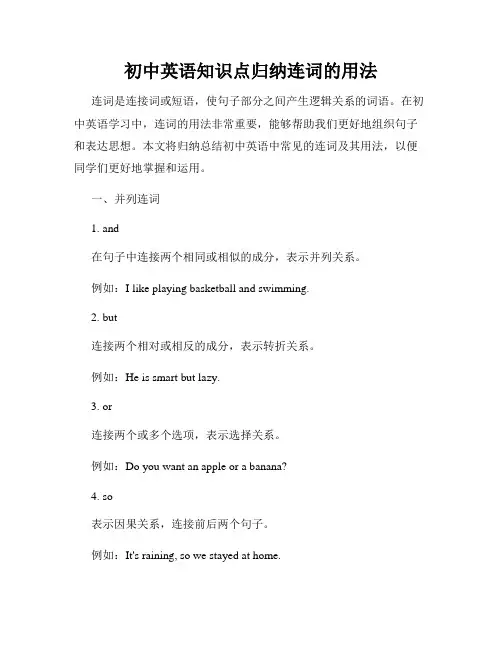
初中英语知识点归纳连词的用法连词是连接词或短语,使句子部分之间产生逻辑关系的词语。
在初中英语学习中,连词的用法非常重要,能够帮助我们更好地组织句子和表达思想。
本文将归纳总结初中英语中常见的连词及其用法,以便同学们更好地掌握和运用。
一、并列连词1. and在句子中连接两个相同或相似的成分,表示并列关系。
例如:I like playing basketball and swimming.2. but连接两个相对或相反的成分,表示转折关系。
例如:He is smart but lazy.3. or连接两个或多个选项,表示选择关系。
例如:Do you want an apple or a banana?4. so表示因果关系,连接前后两个句子。
例如:It's raining, so we stayed at home.二、递进连词1. moreover表示递进关系,引出更多的信息。
例如:He is good at English. Moreover, he is also good at math.2. in addition和 moreover 类似,表示增加信息的递进关系。
例如:She is good at singing. In addition, she can also dance well.三、选择连词1. whether引导一个宾语从句,对两种可能性进行选择。
例如:I haven't decided whether I will go to the party.2. either...or...连接两个相互排斥的选择,表示二者必选其一。
例如:You can either drink tea or coffee.四、让步连词1. although引导让步状语从句,表示相反或意外情况。
例如:Although it's raining, we still went out to play.2. despite和 although 类似,表示尽管有某种情况,但是仍然进行某个行为。
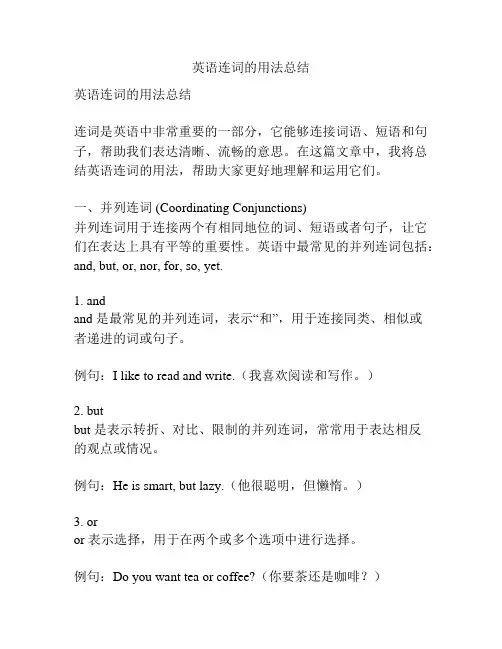
英语连词的用法总结英语连词的用法总结连词是英语中非常重要的一部分,它能够连接词语、短语和句子,帮助我们表达清晰、流畅的意思。
在这篇文章中,我将总结英语连词的用法,帮助大家更好地理解和运用它们。
一、并列连词 (Coordinating Conjunctions)并列连词用于连接两个有相同地位的词、短语或者句子,让它们在表达上具有平等的重要性。
英语中最常见的并列连词包括:and, but, or, nor, for, so, yet.1. andand 是最常见的并列连词,表示“和”,用于连接同类、相似或者递进的词或句子。
例句:I like to read and write.(我喜欢阅读和写作。
)2. butbut 是表示转折、对比、限制的并列连词,常常用于表达相反的观点或情况。
例句:He is smart, but lazy.(他很聪明,但懒惰。
)3. oror 表示选择,用于在两个或多个选项中进行选择。
例句:Do you want tea or coffee?(你要茶还是咖啡?)4. nornor 与 or 相似,但用于否定句中,表示与前面的内容都不同。
例句:He neither drinks nor smokes.(他既不喝酒也不抽烟。
)5. forfor 表示原因或目的。
例句:I study hard, for I want to get good grades.(我努力学习,因为我想取得好成绩。
)6. soso 表示结果或原因,用于连接两个句子。
例句:He is tired, so he wants to take a nap.(他累了,所以想打个盹。
)7. yetyet 表示转折、时间上的久远等,用于连接两个对比强烈的句子。
例句:He is rich, yet unhappy.(他很富有,但不快乐。
)二、从属连词 (Subordinating Conjunctions)从属连词用于连接一个主句和一个从句,它们使得从句变得从属于主句。
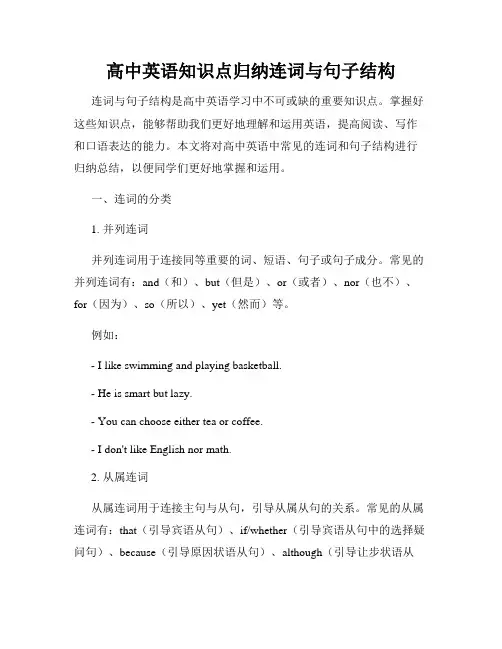
高中英语知识点归纳连词与句子结构连词与句子结构是高中英语学习中不可或缺的重要知识点。
掌握好这些知识点,能够帮助我们更好地理解和运用英语,提高阅读、写作和口语表达的能力。
本文将对高中英语中常见的连词和句子结构进行归纳总结,以便同学们更好地掌握和运用。
一、连词的分类1. 并列连词并列连词用于连接同等重要的词、短语、句子或句子成分。
常见的并列连词有:and(和)、but(但是)、or(或者)、nor(也不)、for(因为)、so(所以)、yet(然而)等。
例如:- I like swimming and playing basketball.- He is smart but lazy.- You can choose either tea or coffee.- I don't like English nor math.2. 从属连词从属连词用于连接主句与从句,引导从属从句的关系。
常见的从属连词有:that(引导宾语从句)、if/whether(引导宾语从句中的选择疑问句)、because(引导原因状语从句)、although(引导让步状语从句)、while(引导时间状语从句)、when(引导时间状语从句)、where(引导地点状语从句)等。
例如:- I know that he is a doctor.- I wonder if/whether she will come to the party.- They canceled the trip because it was raining heavily.- Although it was late, they decided to continue the meeting.3. 连接副词连接副词用于连接词、短语、从句与句子,起到连接的作用。
常见的连接副词有:however(然而)、therefore(因此)、meanwhile(与此同时)、otherwise(否则)、nevertheless(尽管如此)等。
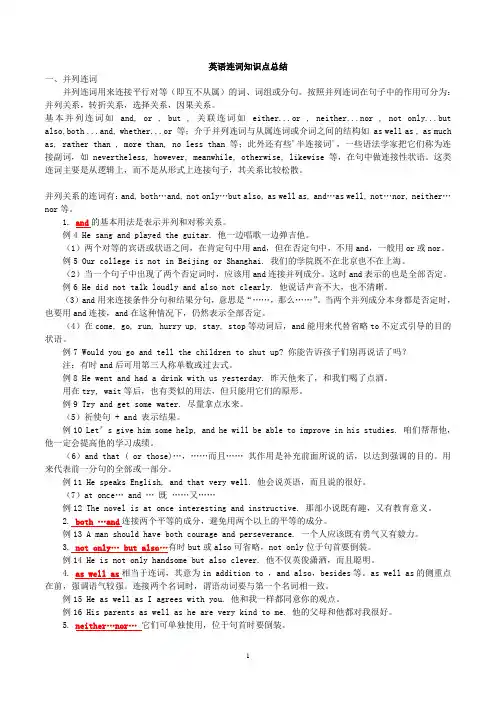
英语连词知识点总结一、并列连词并列连词用来连接平行对等(即互不从属)的词、词组或分句。
按照并列连词在句子中的作用可分为:并列关系,转折关系,选择关系,因果关系。
基本并列连词如and, or , but , 关联连词如either...or , neither...nor , not only...but also,both ...and, whether...or 等;介于并列连词与从属连词或介词之间的结构如 as well as , as much as, rather than , more than, no less than 等;此外还有些'半连接词',一些语法学家把它们称为连接副词,如 nevertheless, however, meanwhile, otherwise, likewise 等,在句中做连接性状语。
这类连词主要是从逻辑上,而不是从形式上连接句子,其关系比较松散。
并列关系的连词有:and, both…and, not only…but also, as well as, and…as well, not…nor, neither…nor等。
1.and的基本用法是表示并列和对称关系。
例4 He sang and played the guitar. 他一边唱歌一边弹吉他。
(1)两个对等的宾语或状语之间,在肯定句中用and,但在否定句中,不用and,一般用or或nor。
例5 Our college is not in Beijing or Shanghai. 我们的学院既不在北京也不在上海。
(2)当一个句子中出现了两个否定词时,应该用and连接并列成分。
这时and表示的也是全部否定。
例6 He did not talk loudly and also not clearly. 他说话声音不大,也不清晰。
(3)and用来连接条件分句和结果分句,意思是“……,那么……”。
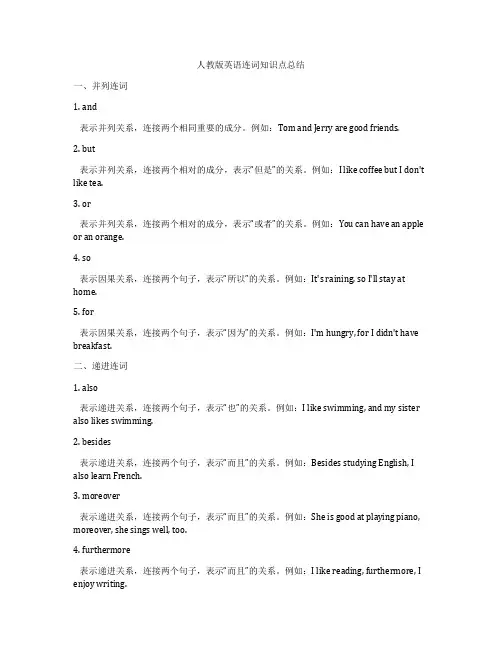
人教版英语连词知识点总结一、并列连词1. and表示并列关系,连接两个相同重要的成分。
例如:Tom and Jerry are good friends.2. but表示并列关系,连接两个相对的成分,表示“但是”的关系。
例如:I like coffee but I don't like tea.3. or表示并列关系,连接两个相对的成分,表示“或者”的关系。
例如:You can have an apple or an orange.4. so表示因果关系,连接两个句子,表示“所以”的关系。
例如:It's raining, so I'll stay at home.5. for表示因果关系,连接两个句子,表示“因为”的关系。
例如:I'm hungry, for I didn't have breakfast.二、递进连词1. also表示递进关系,连接两个句子,表示“也”的关系。
例如:I like swimming, and my sister also likes swimming.2. besides表示递进关系,连接两个句子,表示“而且”的关系。
例如:Besides studying English, I also learn French.3. moreover表示递进关系,连接两个句子,表示“而且”的关系。
例如:She is good at playing piano, moreover, she sings well, too.4. furthermore表示递进关系,连接两个句子,表示“而且”的关系。
例如:I like reading, furthermore, I enjoy writing.三、选择连词1. either…or表示选择关系,连接两个成分,表示“要么…要么”的关系。
例如:You can either have tea or coffee.2. neither…nor表示选择关系,连接两个成分,表示“既不是…也不是”的关系。
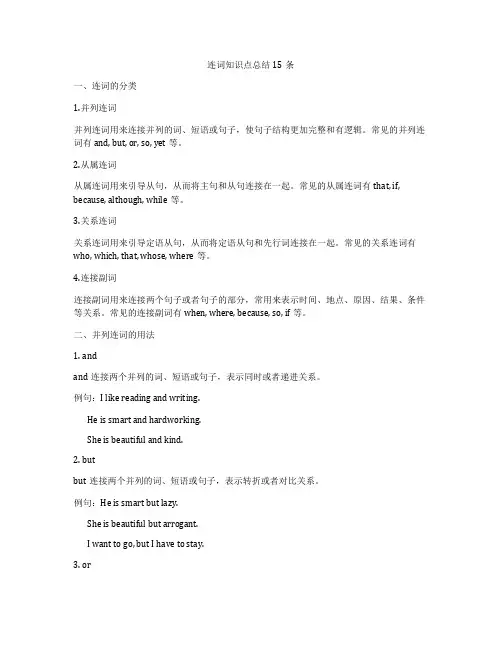
连词知识点总结15条一、连词的分类1.并列连词并列连词用来连接并列的词、短语或句子,使句子结构更加完整和有逻辑。
常见的并列连词有and, but, or, so, yet等。
2.从属连词从属连词用来引导从句,从而将主句和从句连接在一起。
常见的从属连词有that, if, because, although, while等。
3.关系连词关系连词用来引导定语从句,从而将定语从句和先行词连接在一起。
常见的关系连词有who, which, that, whose, where等。
4.连接副词连接副词用来连接两个句子或者句子的部分,常用来表示时间、地点、原因、结果、条件等关系。
常见的连接副词有when, where, because, so, if等。
二、并列连词的用法1. andand连接两个并列的词、短语或句子,表示同时或者递进关系。
例句:I like reading and writing.He is smart and hardworking.She is beautiful and kind.2. butbut连接两个并列的词、短语或句子,表示转折或者对比关系。
例句:He is smart but lazy.She is beautiful but arrogant.I want to go, but I have to stay.3. oror连接两个并列的词、短语或句子,表示选择或者替代关系。
例句:Do you want tea or coffee?You can go by bus or by train.Is it spring or autumn here?4. soso连接两个并列的句子,表示因果关系或者推理结果。
例句:The weather is good, so we can go for a picnic.I studied hard, so I passed the exam.She was tired, so she went to bed early.5. yetyet连接两个并列的句子,表示转折关系或者限制条件。

连词用法总结连词是连接句子、短语或词与词之间关系的重要语法成分。
在英语写作中,合理使用连词能够使文章结构更加清晰明了,句子之间的逻辑关系更加紧密。
本文将对常用的连词用法进行总结,以帮助读者更好地运用连词。
1. 递进关系(addition):连词:and, moreover, furthermore, in addition例句:I am good at playing basketball, and I am also proficient in swimming.(我擅长打篮球,而且我还精通游泳。
)2. 转折关系(contrast):连词:but, however, nevertheless, on the other hand例句:He is intelligent but lazy.(他聪明但懒惰。
)3. 因果关系(cause and effect):连词:because, since, as a result例句:He missed the bus because he woke up late.(他错过了公交车,因为起床晚了。
)4. 条件关系(condition):连词:if, unless, provided that, as long as例句:I will go out for a walk if it stops raining.(如果下雨停了,我会出去散步。
)5. 让步关系(concession):连词:although, even though, despite, in spite of例句:Although she is tired, she still works hard.(虽然她很累,但她还是努力工作。
)6. 目的关系(purpose):连词:so that, in order to, to例句:I study hard so that I can get good grades.(我努力学习,以便能取得好成绩。
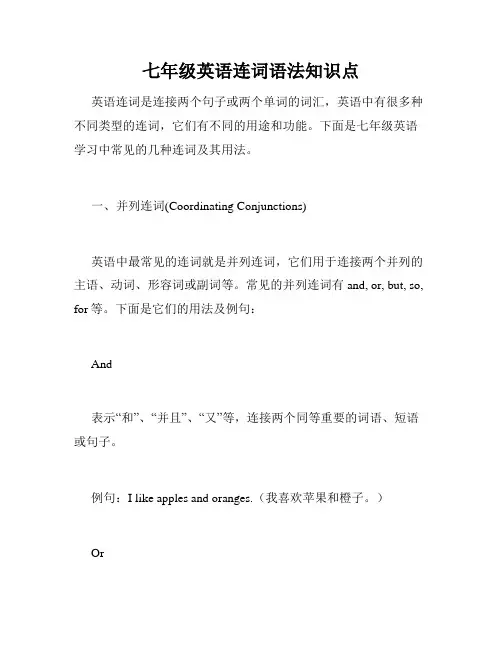
七年级英语连词语法知识点英语连词是连接两个句子或两个单词的词汇,英语中有很多种不同类型的连词,它们有不同的用途和功能。
下面是七年级英语学习中常见的几种连词及其用法。
一、并列连词(Coordinating Conjunctions)英语中最常见的连词就是并列连词,它们用于连接两个并列的主语、动词、形容词或副词等。
常见的并列连词有and, or, but, so, for等。
下面是它们的用法及例句:And表示“和”、“并且”、“又”等,连接两个同等重要的词语、短语或句子。
例句:I like apples and oranges.(我喜欢苹果和橙子。
)Or表示“或者”、“或者是”等,连接两个选择或排除的词语、短语或句子。
例句:Do you want tea or coffee?(你想要茶还是咖啡?)But表示“但是”、“然而”等,连接两个相对而言的信息或情况。
例句:I am tired, but I have to finish my homework.(我很累,但我必须完成我的作业。
)So表示“所以”、“因此”等,连接两个推论或原因与结果的词语、短语或句子。
例句:It's raining, so we should bring an umbrella.(下雨了,我们应该带伞。
)For表示“因为”、“由于”等,连接两个原因与结果的词语、短语或句子。
例句:I can't go to the party, for I have to study.(我不能去参加派对,因为我要学习。
)二、从属连词(Subordinating Conjunctions)从属连词用于连接一个主句和一个从句,从句要依赖于主句而存在。
从句可以是名词性从句、形容词性从句或副词性从句。
常见的从属连词有that, if, because, when, while等。
下面是它们的用法及例句:That在名词性从句中引导从句。
名词性从句可以作主语、宾语、表语或补语。
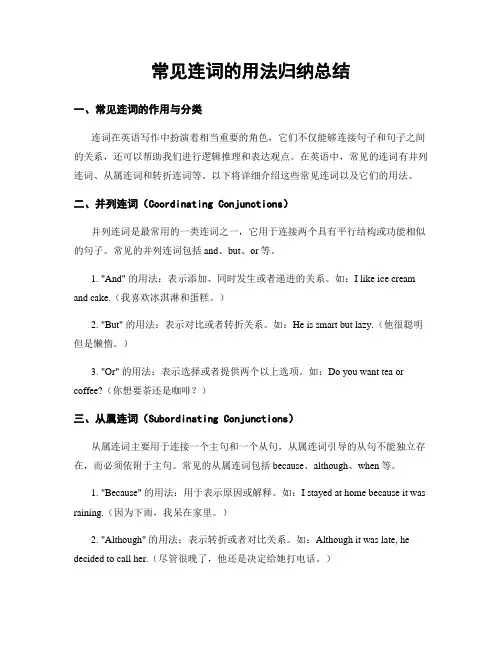
常见连词的用法归纳总结一、常见连词的作用与分类连词在英语写作中扮演着相当重要的角色,它们不仅能够连接句子和句子之间的关系,还可以帮助我们进行逻辑推理和表达观点。
在英语中,常见的连词有并列连词、从属连词和转折连词等。
以下将详细介绍这些常见连词以及它们的用法。
二、并列连词(Coordinating Conjunctions)并列连词是最常用的一类连词之一,它用于连接两个具有平行结构或功能相似的句子。
常见的并列连词包括and、but、or等。
1. "And" 的用法:表示添加、同时发生或者递进的关系。
如:I like ice cream and cake.(我喜欢冰淇淋和蛋糕。
)2. "But" 的用法:表示对比或者转折关系。
如:He is smart but lazy.(他很聪明但是懒惰。
)3. "Or" 的用法:表示选择或者提供两个以上选项。
如:Do you want tea or coffee?(你想要茶还是咖啡?)三、从属连词(Subordinating Conjunctions)从属连词主要用于连接一个主句和一个从句,从属连词引导的从句不能独立存在,而必须依附于主句。
常见的从属连词包括because、although、when等。
1. "Because" 的用法:用于表示原因或解释。
如:I stayed at home because it was raining.(因为下雨,我呆在家里。
)2. "Although" 的用法:表示转折或者对比关系。
如:Although it was late, he decided to call her.(尽管很晚了,他还是决定给她打电话。
)3. "When" 的用法:表示时间或条件关系。
如:I will call you when I arrive.(我一到就会给你打电话。
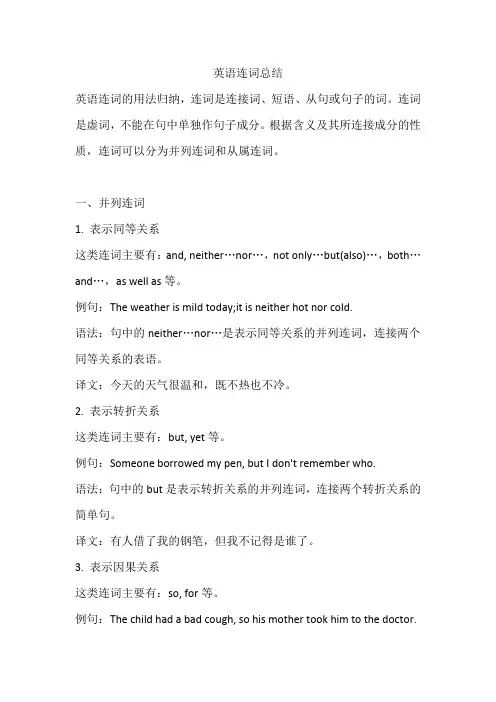
英语连词总结英语连词的用法归纳,连词是连接词、短语、从句或句子的词。
连词是虚词,不能在句中单独作句子成分。
根据含义及其所连接成分的性质,连词可以分为并列连词和从属连词。
一、并列连词1. 表示同等关系这类连词主要有:and, neither…nor…,not only…but(also)…,both…and…,as well as等。
例句:The weather is mild today;it is neither hot nor cold.语法:句中的neither…nor…是表示同等关系的并列连词,连接两个同等关系的表语。
译文:今天的天气很温和,既不热也不冷。
2. 表示转折关系这类连词主要有:but, yet等。
例句:Someone borrowed my pen, but I don't remember who.语法:句中的but是表示转折关系的并列连词,连接两个转折关系的简单句。
译文:有人借了我的钢笔,但我不记得是谁了。
3. 表示因果关系这类连词主要有:so, for等。
例句:The child had a bad cough, so his mother took him to the doctor.语法:句中的so是表示因果关系的并列连词,连接两个因果关系的简单句。
译文:这个孩子咳嗽得很严重,所以他的妈妈带他去看医生。
4. 表示对比关系这类连词主要有:while, whereas等。
例句:Some people praise him, whereas others condemn him.语法:句中的whereas是表示对比关系的并列连词,连接两个对比关系的简单句。
译文:有些人赞扬他,而有些人谴责他。
5. 表示选择关系这类连词主要有or, either…or…等。
例句:Either you can talk to him, or I will.语法:句中的Either…or…是表示选择关系的并列连词,连接两个选择关系的简单句。
初中英语知识点归纳常用的连词和方式状语从句的连接连词在英语中起着承接、转折、因果、条件等作用,对于语句的衔接起着重要的作用。
而方式状语从句则是描述某个动作或者状态是如何发生的。
在初中英语中,掌握常用的连词和方式状语从句的连接方法对于提高阅读、写作和口语表达能力非常重要。
本文将归纳总结常用的连词和方式状语从句的连接。
一、常用的连词1. 转折关系的连词“but”和“however”是表示转折关系的连词,用于连接两个相对矛盾的观点或情况。
例如:- He wants to go out, but it's raining outside.- I'm tired, however, I'll keep working.2. 承接关系的连词“and”和“also”是表示承接关系的连词,用于连接两个相对相似或递进的观点或情况。
例如:- I like swimming, and I also enjoy diving.- He is good at math, and he is also good at physics.3. 因果关系的连词“because”和“so”是表示因果关系的连词,用于连接原因和结果。
例如:- I couldn't finish my homework because I was sick.- He studied hard, so he got a high score.4. 条件关系的连词“if”和“unless”是表示条件关系的连词,用于连接条件和结果。
例如:- If it rains tomorrow, we will stay at home.- I won't go to the party unless you invite me.5. 选择关系的连词“either...or”和“neither...nor”是表示选择关系的连词,用于连接两个相对对立的选择。
初中英语知识归纳常用连词和短语的用法连词(Conjunction)是连接词与词、短语与短语及句子与句子之间关系的词。
在英语中,连词常被用来连接句子成为复合句,使句子结构更加丰富多样。
下面,我们将归纳总结一些常用的连词和短语的用法。
1. 并列连词(Coordinating Conjunctions)并列连词用于连接两个相同类型的句子或词语。
常见的并列连词有:and(和)、but(但是)、or(或者)、so(所以)、for(因为)等。
例如:- He is smart and hardworking.(他聪明且努力。
)- I like tea but I don't like coffee.(我喜欢茶但不喜欢咖啡。
)- You can choose either the blue one or the green one.(你可以选择蓝色的或绿色的。
)- It's raining, so we should bring an umbrella.(下雨了,所以我们应该带把伞。
)- I want to go to the park, for I like the fresh air there.(我想去公园,因为我喜欢那里的新鲜空气。
)2. 递进连词(Subordinating Conjunctions)递进连词用于表示一个句子或短语对另一个句子或短语的递进关系。
常见的递进连词有:as(如同)、since(因为)、because(因为)、while(当)、although(尽管)等。
例如:- She works hard as she wants to achieve her goals.(她努力工作,因为她想实现她的目标。
)- Since it's getting late, we should go home now.(因为时间已经很晚了,我们应该回家了。
)- They won the game because they played well as a team.(他们之所以赢得比赛,是因为作为一个团队他们表现出色。
连接词汇总掌握连接词的正确用法连接词汇总:掌握连接词的正确用法在英语写作中,连接词起到连接句子和段落的作用,使文章更加连贯和流畅。
正确使用连接词可以使文章层次更加清晰,同时也能使读者更好地理解作者的观点。
本文将为您总结一些常用的连接词以及它们的正确用法。
1. 并列连接词(Coordinating Conjunctions)并列连接词用于连接并列的词、短语、句子或段落,使它们具有平等的关系。
1.1 and: 表示相似或补充关系。
例如:I like to read books, and my sister likes to watch movies.1.2 or: 表示选择关系。
例如:You can either go to the beach or stay at home.1.3 but: 表示转折关系。
例如:He is smart, but he is lazy.2. 时间连接词(Temporal Connectors)时间连接词用于表示事件或行为之间的时间关系。
2.1 before: 表示在某个时间或事件之前。
例如:He arrived before the party started.2.2 after: 表示在某个时间或事件之后。
例如:She went to bed after finishing her homework.2.3 while: 表示两个事件同时发生。
例如:He was reading a book while I was cooking.3. 原因连接词(Causal Connectors)原因连接词用于表示某个事件或行为的原因。
3.1 because: 表示原因。
例如:She couldn't attend the meeting because she was sick.3.2 since: 表示从过去某个时间点开始的原因。
例如:I haven't seen him since last week.3.3 as: 表示两个行为同时发生的原因。
初中英语知识点总结:连词知识点总结在初中英语的学习中,连词是一个重要的语法知识点。
它像桥梁一样,将句子的各个部分连接起来,使语言表达更加清晰、流畅。
下面我们就来详细总结一下初中英语中常见的连词。
一、并列连词1、表示并列关系and:“和,并且”,连接两个或多个相似的成分。
例如:I like apples and bananas (我喜欢苹果和香蕉。
)bothand:“两者都”,连接两个并列的主语、宾语、谓语等。
例如:Both Tom and Jerry are my friends (汤姆和杰瑞都是我的朋友。
)2、表示选择关系or:“或者,否则”,用于连接两个或多个可供选择的成分。
例如:You can take the bus or the taxi (你可以乘公交车或者出租车。
) eitheror:“要么……要么……”,连接两个并列的成分,表示两者之中选择其一。
例如:Either you or I am wrong (要么你错了,要么我错了。
)3、表示转折关系but:“但是”,连接两个意思相反或相对的成分。
例如:He is rich but not happy (他富有但不快乐。
)while:“然而”,强调对比。
例如:I like singing while she likes dancing (我喜欢唱歌,而她喜欢跳舞。
)4、表示因果关系for:“因为”,用于补充说明理由。
例如:It must have rained last night, for the ground is wet (昨晚一定下雨了,因为地面是湿的。
)二、从属连词1、引导时间状语从句when:“当……时候”,表示动作发生的时间。
例如:When I got home, my mother was cooking (当我到家时,我妈妈正在做饭。
) while:“在……期间,当……时候”,强调动作的同时性。
例如:While I was reading, he was playing games (我在读书的时候,他在玩游戏。
英语连词知识点总结一、并列连词并列连词用于连接两个相同或类似的句子成分,使它们在意义上并列。
常见的并列连词包括and、but、or、so等。
它们用于连接并列的短语、从句或句子,使得两个或多个成分具有平行的关系,表达并列的意思。
例如:- He is tall and strong.(他又高又壮。
)- I like tea but I don't like coffee.(我喜欢茶,但不喜欢咖啡。
)- You can stay at home or go out with me.(你可以呆在家里,也可以和我一起出去。
)二、从属连词从属连词用于连接主从复合句的主从句部分,引导从句中的内容,使其成为主句的一部分。
常见的从属连词包括that、if、whether、because、although等。
它们引导从句时,表示从属关系、条件、原因、让步等。
例如:- I know that he is coming.(我知道他要来了。
)- If it rains, we will stay at home.(如果下雨,我们就呆在家里。
)- She asked me whether I liked the movie.(她问我喜不喜欢这部电影。
)三、关联连词关联连词用于连接句子中两个部分,使它们在语义上有一定的联系,常见的关联连词包括although、because、since、as、so that等。
它们引导从句时,表示对比、因果、时间、目的等关系。
例如:- Although it's raining, I will go out.(虽然下雨,但我还是要出门。
)- I went to bed early because I was tired.(我早早地上床了,因为我很累。
)- He is studying hard so that he can pass the exam.(他努力学习,以便能通过考试。
常见英文连接词和句型总结常用句型(一)段首句1.关于人们有不同的观点一些人认为There are different opinions among people as toSome people suggest that 2.俗话说(常言道),它是我们前辈的经历,但是,即使在今天,它在许多场合仍然适用。
There is an old sayingIt s the experience of our forefathers,however,it is correct in many cases even today. 3. 现在,,它们给我们的日常生活带来了许多危害。
首先,;其次,。
更为糟糕的是。
Today, which have brought a lot of harms in our daily life. First, Second,What makes things worse is that. 4. 现在,很普遍,许多人喜欢,因为,另外(而且)。
Nowadays,it is common to . Many people like because Besides,5.任何事物都是有两面性,也不例外。
它既有有利的一面,也有不利的一面。
Everything has two sides and is not an exception ,it has both advantages and disadvantages. 6.关于人们的观点各不相同,一些人认为(说),在他们看来,People's opinions about vary from person to person. Some people say that To them, 7. 人类正面临着一个严重的问题,这个问题变得越来越严重。
Man is now facing a big problem which is becoming more and more serious. 8.已成为人的关注的热门话题,特别是在年青人当中,将引发激烈的辩论。
常见英文连接词和句
型总结
作文过渡词的用法
1、表示时间的
at first 起初 next 接下来 then 然后
after that 那以后 later 后来 soon 不久soon/shortly after ……之后不久finally 最后 in the end 最后 eventually 最终 at last 最后
lately 近来 recently 最近now=at present=nowadays
since then 自从那时起 after that 那以后
after a while 一会儿 afterward 后来
to begin/start with=in the first place 首先、第一点 immediately马上meanwhile=in the meantime=at the same time 在此期间、同时
until now 直到现在
suddenly=all of a sudden 突然 as a young man 当…… 是个年轻人的时候at the age of… 在……岁的时候 as soon as 一……就……
early in the morning 大清早 after/before dark 天黑后/前
from now on从现在开始 from then on 从那时开始
2、表示列举和时序
first, second, third…finally last but not the least最后但并非最不重要的firstly, secondly, thirdly…finally first of all, 首先
for one thing其一 for another其二, at the same time , at first , at last 3、表示列举
for example 例如: that is (to say) 也就是说
such as 如…… take…for example 拿……来说 like 像……
4、表示比较或对比
like 像 unlike 不像 compared to(with )与……相比 while 而
on the contrary 正相反 be different from 与……不同
on (the) one hand… on the other hand 一方面……另一方面
5、表示增补
and 而且
both…and 不但……而且not only…but also 不但……而且 as well as 不但……而且
besides此外、而且 in addition 并且
what's more 而且 for another 另一方面
worse still=what's worse=to make matter worse 更糟糕的是 including 包括
6、表示因果
because 因为 since 既然 as 由于 now that 既然
therefore 因此 thus 这样 so 所以 as a result (of) 结果
because of=on account of 因为 thanks to 多亏、由于
for this reason 由于这个原因 if so 如果这样 if not 如果不是这样
7、表示目的
for this purpose in order to do
so as to do so that… in order that…
8、表示让步
though/although no matter+疑问句 in spite of 尽管
whatever/however/whoever even if/ even though 即使
9、表示递进或强调
besides 况且 what's more 更重要地是 thus 这样 above all 首先 iin fact= as a matter of fact 事实上 in other words 换句话说
in that case 那样的话
10、表示转折
but 但是 still 然而 however 然而 while 而
11、表示总结
in a/one word 简而言之、总之 generally speaking 一般说来
in short=in a few words=in brief 简而言之
on the whole=taking everything into consideration 从总体来看、大体上
so 所以 therefore 因此 thus 这样
as has been mentioned 正如所提到的 it is quite clear that 很显然
there is no doubt that 毫无疑问 it is well-known that 大家都知道
as we all know=as is known to us all 大家都知道 as/so far as I know 据我所知
to sum up=to summarize=in summary 总之
12、表示转折话题
by the way 顺便说 I am afraid 我恐怕 in my opinion 依我看来
to tell the truth 说实话 to be honest 诚实地说 in fact=actually=as a matter of fact事实上
表示观点:personally 就我个人而言 in my opinion as far as I know 据我所知what I want to stress is that …我想强调的是 sb hold the opinion that…某人持有……什么观点according to sb依照某人的观点看
常用的句型有:
1.一般作文都是讨论一个话题,一部分人的观点是。
,另一部分的观点是。
我的观点是。
对于这种作文非常好的句式:recently we have held a discussion about /on...... Some people think that....,while others don’t think so....In my point of view,.... 再把具体问题套用进去,非常流畅而且不错的一篇文章就可以浮出水面了。
2. As the proverb goes: “Every coin has its two sides”, television has both advantages and disadvantages.正像谚语所说:“任何硬币都有两面”,电视既有优点也有缺点。
“中学生是否可以在校使用手机”你班就此话题进行了讨论。
请你根据以下记录表写一篇短文,陈述讨论结果并发表你的观点。
要求:1短文应包括表中所给信息
2补全表中的理由,同时发表你的观点
3文中不得出现与你身份相关的信息
4 80-100词,开头已给出,不计入总词数
Recently we have held a discussion about whether the students should use mobile phones at school or not. Some of us think mobile phones should be used at school. First, we can surf the Internet for information we need. Second, with mobile phones we can play games for enjoyment in our free time. Finally, we can call our parents easily.
However , some other students don’t think so. On one hand, some students send messages in class. On the other hand, we can use the school public phones, Besides, keeping a mobile phone costs money.
In my opinion ,it’s not a good idea to use mobile phones at school because it’s bad for our study.
(For me, bringing a mobile phone to school is good because I can play games to relax myself when I’m free.)。